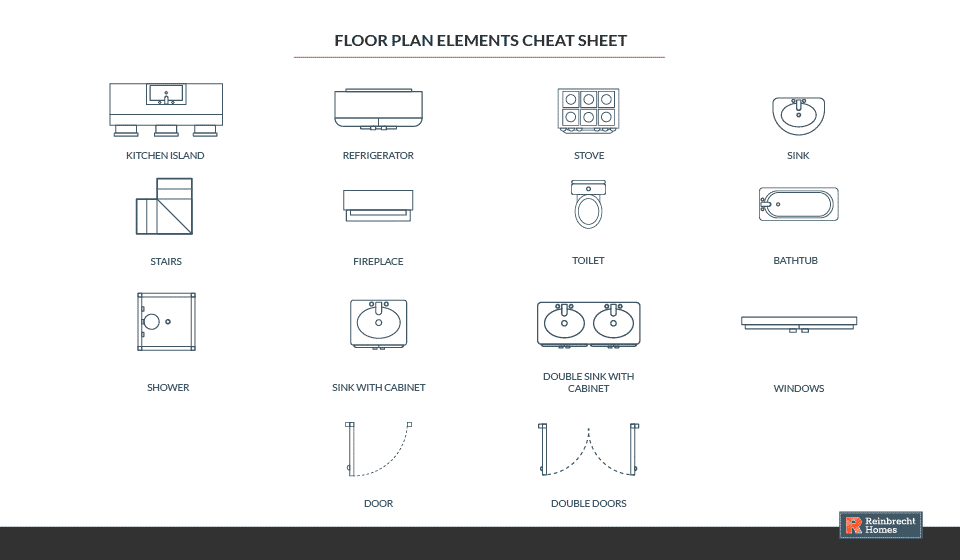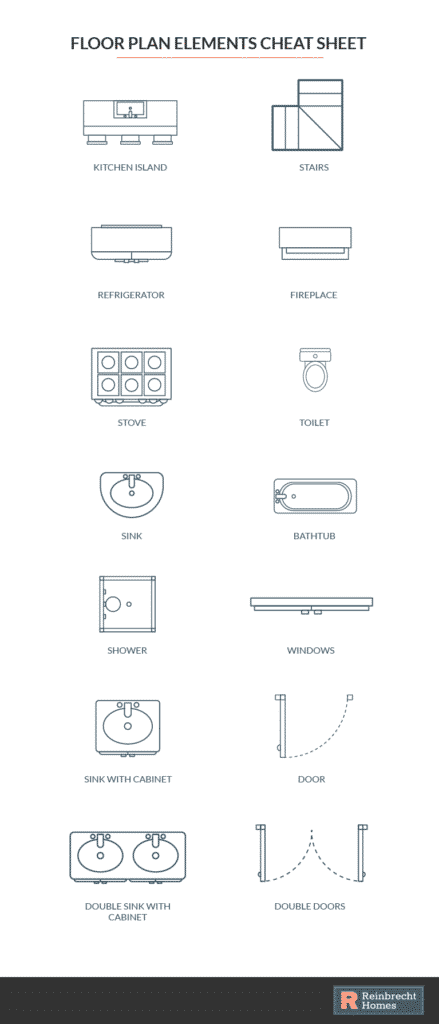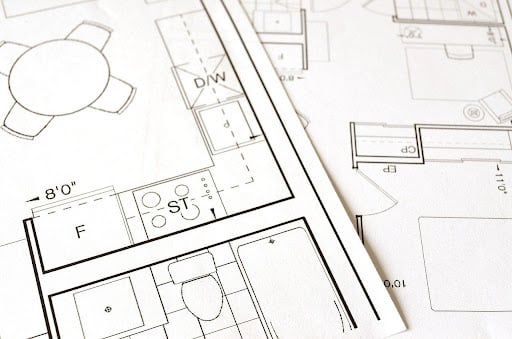When planning your new home, it’s easy to get caught up in fine details. Deciding what carpet to use or what color to paint the walls can feel like the most important choice in the world. However, if you’re too caught up in these little details, you can speed through a much more important decision: your home’s layout.
Rushing through is just one problem you can face when choosing your new home’s floor plan. You can change the paint and flooring, but the floor plan is more permanent. Here are eight mistakes you should watch out for when choosing your new home floor plan.
1. Not Picking an Appropriate Floor Plan Size
The most basic consideration for your new home floor plan is size. There’s a big difference between a 1000 sq. ft. floor plan and a 3000 sq. ft. layout. Before you decide on the number of rooms, you’ll need to choose how much space you want.
A floor plan that’s too small will leave you feeling cramped as long as you live in the home. On the other hand, a floor plan that’s too big will force you to spend more on upkeep and utilities to maintain space you don’t use.
You want to find the Goldilocks zone for your floor plan: not too big, not too small, but just right. To narrow down the size of your floor plan, consider things like:
- Family size: In general, each person in a home requires at least 200-600 square feet of space to feel comfortable. For instance, if you have a family of four, you should probably look for a floor plan with 800 to 2400 square feet of room. Active families will need more room, while more sedentary people will probably be fine with less space.
- Maintenance priorities: The higher the square footage in your home, the more space you’ll need to keep clean. Furthermore, extra bathrooms and amenities mean more potential maintenance over time. Think about how much time and money you want to spend keeping things in good condition.
- Budget: Larger floor plans cost more than smaller layouts with equivalent amenities. Choosing a smaller floor plan may give you more budgetary wiggle room to upgrade furnishings and fixtures.
- Furniture: Do you have a king-size bed? Do you have a dresser or wardrobe set? Your master bedroom needs enough room to fit all of that and still let you move around. Similarly, your living room should be big enough to house your couch and TV, and your kitchen or dining room should be large enough to fit your dinner table and chairs. Measure your furniture and make sure everything will fit nicely in the new home floor plan.
2. Not Considering Your Lifestyle
Your home is where you live, and you need space for the things that matter to you. That’s why the most fundamental consideration for your new home floor plan is your lifestyle. A large family with pets may need a very different layout than a retired couple running a business from home.
Some of the lifestyle considerations to keep in mind when you choose your floorplan include:
- How many people will live in the home: If you’re housing a family of six, you’ll need more bedrooms and bathrooms than you would for two. You should also think about how your lifestyle and needs may change in the future. If your kids are older, think about how you could find new uses for the space when they fly the coop.
- Whether you run a business or work from home: You may need a dedicated office space if you’re a remote worker or run a business. An office is much more than just an additional bedroom; it should be secluded and away from louder sections of the house to help you focus.
- Whether you prefer to cook or order out: If you’re a fan of takeout, you may be okay with a small galley kitchen. If you intend on hosting holidays at your new home, it’s a better idea to integrate a large, functional kitchen to support your cooking needs.
- How mobile you are: Certain floor plans are much harder for people with limited mobility to navigate. A home with three sets of stairs, for instance, might not be the best choice for older people. If you’re building your forever home, keep your future limitations in mind.
- How often you entertain: If you regularly host guests, think about where you’ll spend time with them. Your new home floor plan should offer enough space for you and your guests to socialize in the same room.
3. Not Involving the Whole Family
If you’re building a house you intend to share with others, you should consider their opinions. Obviously, a family of six will benefit from having at least five bedrooms and two bathrooms. However, you should also get family feedback about other features.
Your family members will spend just as much time in the home as you do. Failing to take their opinions into account can lead to disappointment. There may be minor adjustments you can make to the layout that makes all the difference to your spouse or children. For instance, a larger closet in a child’s bedroom or a breakfast nook with south-facing windows are simple to add and could dramatically improve your family’s satisfaction with your new home.
The best way to accomplish this is by calling a family meeting. Get everyone’s input on features they care about. You may not be able to include every, but you can try. Remember, it’s everyone’s home. Choosing your floor plan is your best chance to make the home appealing to everyone.
4. Not Doing Your Research
Some floor plans can come with hidden costs and drawbacks. If you don’t do your research, you can wind up with a floor plan that isn’t suited to your needs or local conditions.
You should investigate your lot when choosing your floor plan. Does the lot get plenty of sunshine? Is there a tree on a neighbor’s property that shades part of the property? The answers to these questions will help you decide whether a picture window or skylight is worth it. If you want natural light in your home, you’ll want more windows on the south, east, and west sides as long as other features don’t shade them.
Other things to research include:
- Environmental issues: The weather in your area will make a big difference to your floorplan, even beyond considerations like windows. Sites that get lots of snow may need a roof with a steep slope critical for safety. This can completely change the design of your second story.
- Utility bills: If you live somewhere hot, a floor-to-ceiling window on the south side of your home will make your home much hotter in the summer. On the other hand, that same well-insulated window can keep cold-climate homes warmer in the winter. Research how different floor plans can affect your utility bills before making a choice.
- Building set backs: Lines, utility easements, and drainage easements on your lot can greatly impact the type and shape of home that your lot can accommodate. This lot research goes hand in hand with the design of your home and both are critically important. Some floor plans simply can not be build on certain lots even if they physically fit due to easements that may exist. If you are not sure, ask your builder.
5. Not Thinking About Room, Door, and Window Placement
Part of the research is thinking carefully about how rooms flow and where windows and doors are placed. As a general rule, bedrooms are best away from the street, and living rooms and bathrooms work better when close to the front of the home. This keeps sleeping spaces away from noisy areas and ensures your guests don’t have to walk through your entire house to get to the sitting room.
You should also think about the windows and doors in each room. Awkward window and door placements can make arranging furniture within a space difficult. For example, when considering living room spaces, think about where you’ll place couches and TVs. A giant picture window may look appealing from the street, but it can make spending time in the space harder.
6. Not Asking Questions When You Don't Understand
Architectural drawings can be confusing for new homebuyers. If you don’t understand these drawings, you’re in good company. Like many people, you may be afraid to ask questions if you don’t understand something. However, that’s the most crucial time to talk to your builder.
Your builder and architect are there to help you understand the home you want to build. If something about the floor plan doesn’t make sense to you, talk about it. Your building team is there to make sure you know what you’re getting into and answer your questions.
You’re the one who needs to live in the home, after all. If you stay quiet about a question, you might find out it doesn’t look the way you thought it would once construction has begun.
There’s no concern too small or “stupid,” either. Make sure you understand precisely where each staircase, window, and door go in the plan. Even details like where doors swing or how far oven and fridge doors open can make a difference in how livable your home is over the long term. It’s always easier to fix problems like these in the planning stage.


7. Not Enough Storage Space
Storage spaces are sometimes an afterthought. The cliché “out of sight, out of mind” applies to closets and basement storage rooms as much as the stuff they contain. However, skimping on storage space is a major regret for many homeowners.
It’s usually better to invest in too much storage space rather than not enough. It’s hard to add extra storage space into your home’s floor plan, especially if you’re looking for a more compact layout. If you don’t have enough room to store everything you own, you’re quickly going to face problems keeping your home organized and clean.
If you’re a current homeowner, think about the storage space you already have. Do you have enough? Is there a certain kind of storage you’re missing, like extra garage space or kitchen cabinets? Don’t assume you’ll be able to reduce clutter during your move. Make sure you choose a floor plan with at least as much storage as your current living space, if not more. This will give you room to expand in the future.
8. Not Considering the Future
The last thing to remember is that your life circumstances change. If you’re building your home, you probably intend to spend a long time in it. Over the decades, lots of things can change.
You may have kids, or your children may grow up and leave home. Your mobility may decrease, or you could take up new hobbies or change your working habits. The floor plan should accommodate these kinds of changes without missing a step.
A future-proof floor plan looks different for everyone. You might look for a layout with at least one bedroom on the first floor to make going to bed easier in your old age. You could also look for open floor plans that give you plenty of room to rearrange. The important thing is to think about what you expect from your future and choose a layout that will work just as well in twenty years as it does today.
Find the Floor Plan That Fits Your Needs
Choosing your floor plan is a big decision, and you don’t have to make it alone. By working with a trusted home builder, you can get help sorting through different possibilities to find the perfect layout for your future home.
Reinbrecht Homes is available for just that. You can get in touch today to learn how the experts at Reinbrecht Homes will help you find the perfect floor plan for your lifestyle.




